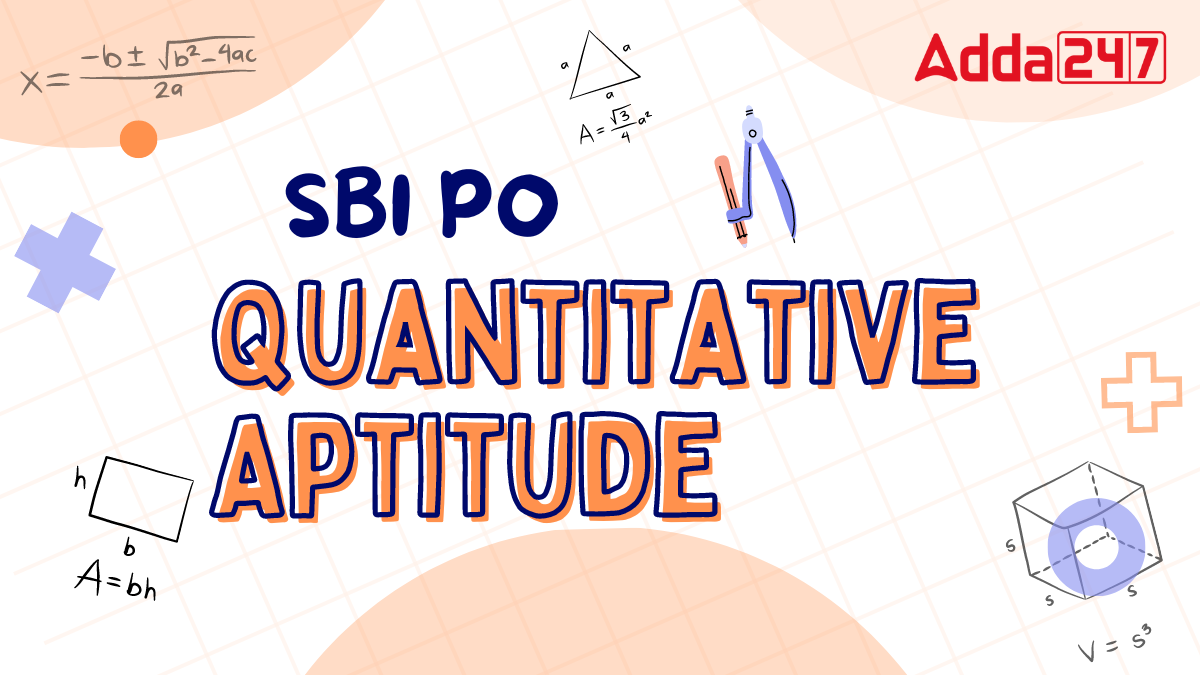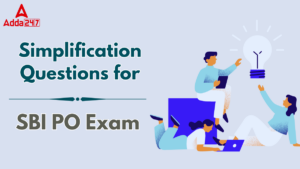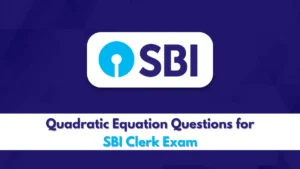Table of Contents
Do you consider Quantitative Aptitude to be one of the most challenging sections in the SBI PO Exam? SBI PO Exam serves as a gateway to a prestigious career in the banking sector, with the Quantitative Aptitude section being crucial for selection. Although challenging this section can be managed effectively with the right strategy and preparation. The aspiring candidates can refer to the below article for the Important Questions, Preparation Tips for SBI PO Quantitative Aptitude 2025.
SBI PO Quantitative Aptitude Section
The SBI PO 2025 Quantitative Aptitude section assesses a candidate’s numerical ability and problem-solving skills. It includes questions on topics like arithmetic, algebra, data interpretation, number systems, probability, etc.
- Preliminary Examination: 30 Questions= 30 marks (20 minutes)
- Mains Examination: (Data Analysis & Interpretation) 30 Questions= 60 marks (45 minutes)
SBI PO Quantitative Aptitude Syllabus
SBI PO Quantitative Aptitude Syllabus comprises topics and their sub-topics. The various topics that an aspirant has to prepare to ace the SBI PO Exam have been listed in the below table.
| SBI PO Quantitative Aptitude Syllabus | |
| Topic | Sub Topic |
| Data Interpretation | Bar Graph, Line Graph, Pie Chart, Tables, Caselet DI |
| Number Series | Missing Number Series, Wrong Number Series |
| Simplification | BODMAS, Square & Cube, Square & cube root, Indices, fraction, percentage, etc. |
| Approximation | BODMAS, Square & Cube, Square & cube root, Indices, fraction, percentage, etc. |
| Quadratic Equation | |
| Arithmetic | Percentage, Ratio & Proportion, Interest, Profit & Loss, Average, Mixture & Allegation, Time & Work, Speed, Time & Distance, etc. |
Preparation Tips for SBI PO Quantitative Aptitude
To qualify SBI PO Exam 2025, aspirants need to follow a proper strategy which must include the basic preparation tips. Some of the general tips for SBI PO Quantitative Aptitude 2025 have been discussed in the given section.
- Understand the Basics: Ensure a strong grasp of basic mathematical concepts and formulas. This foundation is crucial for solving complex problems.
- Practice Regularly: Consistent practice is key. Solve a variety of problems daily to improve speed and accuracy. Use mock tests and previous years’ papers to simulate exam conditions.
- Focus on Data Interpretation: Since data interpretation questions are a significant part of the exam, practice various types of graphs and charts. Work on quick calculation techniques to save time.
- Time Management: During practice, time yourself. Aim to reduce the time taken for each question without compromising on accuracy. Learn shortcuts and tricks for faster calculations.
- Analyze Your Performance: Regularly analyze your performance in mock tests. Identify weak areas and work on them diligently. Understand the mistakes and learn how to avoid them.
- Maintain a Positive Attitude: Confidence plays a crucial role. Stay positive and believe in your preparation. A calm and focused mind can solve problems more efficiently.
Questions for Quantitative Aptitude SBI PO
Below are some Quantitative Aptitude Questions for the SBXI PO exam:
Direction (1 – 5): In the given questions, two quantities are given one as ‘Quantity I’ and another as ‘Quantity II’. You have to determine the relationship between these two quantities and choose the appropriate option.
Q1. A and B invested in the ratio of 32 : 33 respectively in a business and A and B invested for 11 months and 9 months respectively. B gets Rs 2500 less profit than A at the end of business.
Quantity I – profit share of B.
Quantity II – 15000 Rs.
(a) Quantity I > Quantity II
(b) Quantity I < Quantity II
(c) Quantity I ≥ Quantity II
(d) Quantity I ≤ Quantity II
(e) Quantity I = Quantity II or no relation
Q2. Veer sold an apple at Rs. 48 which costs him Rs. ‘x’ and he gained in this transaction.
Quantity I – find value of (x + 20) Rs.
Quantity II – 60 Rs.
(a) Quantity I = Quantity II or no relation
(b) Quantity I < Quantity II
(c) Quantity I ≥ Quantity II
(d) Quantity I ≤ Quantity II
(e) Quantity I > Quantity II
Q3. X women together can do a work in (X – 28) days, while (X + 12) women together can do the same work in (X – 32) days.
Quantity I – women together can do the same work in how many days?
Quantity II – 24 days
(a) Quantity I = Quantity II or no relation
(b) Quantity I < Quantity II
(c) Quantity I ≥ Quantity II
(d) Quantity I > Quantity II
(e) Quantity I ≤ Quantity II
Q4. Train P and Q are running at the speed of ‘S’ km/hr and (S + 36) km/hr respectively. When both trains running in the same direction, crosses each other in seconds, while when both trains running in the opposite direction, crosses each other in seconds.
Quantity I – Sum of speed of both trains (in km/hr).
Quantity II – 126 km/hr
(a) Quantity I = Quantity II or no relation
(b) Quantity I < Quantity II
(c) Quantity I ≥ Quantity II
(d) Quantity I > Quantity II
(e) Quantity I ≤ Quantity II
Q5. An amount was lent at 25% p.a. C.I. compounding annually and difference between interest accrued for first year and second year is Rs. 750.
Quantity I – Find the amount lent.
Quantity II – 12500 Rs.
(a) Quantity I = Quantity II or no relation
(b) Quantity I < Quantity II
(c) Quantity I ≥ Quantity II
(d) Quantity I > Quantity II
(e) Quantity I ≤ Quantity II
Direction (6 – 10): The following table shows the total number of customers visited in five different branches (A, B, C, D & E) of two different banks (PNB & BOB) and percentage of female customers visited out of total customers visited in these 5 branches of these 2 banks. Read the data carefully and answer the questions. Some data are missing in the table. You have to calculate that data according to the information given in the questions.
| Branches | Total customers visited in PNB | Percentage of female costumers visited in PNB | Total customers visited in BOB | Percentage of female costumers visited in BOB |
| A | 900 | 32% | ___ | 44% |
| B | 520 | 45% | 500 | 24% |
| C | ___ | 38% | ___ | 60% |
| D | 1120 | ___ | 1584 | 25% |
| E | 440 | 35% | 700 | ___ |
Q6. If total number of customers visited to branch C of both the banks together is 3250, while total female costumers visited to branch C of both the banks together is 1532, then find difference between total number of customers visited to branch C of both the banks?
(a) 560
(b) 550
(c) 500
(d) 520
(e) 650
Q7. The number of female customers visited in branch A of PNB are approximately what percent of number of female customers visited in branch D of BOB?
(a) 65%
(b) 70%
(c) 75%
(d) 73%
(e) 80%
Q8. If the number of female customers visited in branch A of BOB are four less than double of the number of female costumers visited in branch A of PNB, then find the total number of customers visited to branch A of BOB.
(a) 1250
(b) 1300
(c) 1400
(d) 1350
(e) 1200
Q9. If number of female customers visited in branch F of BOB are less than number of female customers visited in branch E of same bank, while total number of customers visited to branch F of BOB is 800 , then find the percentage of female costumers out of total customers visited in branch F of BOB?
(a)25.5%
(b) 26.5%
(c) 27.5%
(d) data inadequate
(e) None of these
Q10. Find the total number of female customers visited to branch B of both the banks together?
(a) 344
(b) 384
(c) 374
(d) 354
(e) None of these
Direction (11 – 15): What will come in the place of question (?) mark in following number series.
Q11. ?, 896, 5376, 26880, 107520, 322560
(a) 108
(b) 98
(c) 138
(d) 128
(e) 118
Q12. 22, 347, 604, 801, ?, 1047
(a) 946
(b) 948
(c) 952
(d) 944
(e) 950
Q13. 17, ?, 10, 16.5, 35, 90
(a) 8
(b) 9.5
(c) 10
(d) 8.5
(e) 9
Q14. 1284, ?, 1276, 1332, 1268, 1324
(a) 1352
(b) 1346
(c) 1348
(d) 1340
(e) 1342
Q15. 1600, ?, 2000, 6000, 3000, 3000
(a) 8400
(b) 9000
(c) 8000
(d) 6400
(e) 3200
Q16. The profit share of Anurag is Rs. 2400 out of the total profit of Rs. 3600 and he had invested Rs.3200 more amount than Bhavya for 8 months. Bhavya invested her amount for the whole year. Find the amount invested by Anurag?
(a) 4000 Rs.
(b) 6000 Rs.
(c) 1600 Rs.
(d) 2400 Rs.
(e) 4800 Rs.
Q17. Time taken by Ayush and Veer together to complete a piece of work is equal to time taken by Charu to complete the same work alone. Veer working alone can complete the same work in 45 days and Charu’s efficiency is 225% of efficiency of Veer. Find time taken by Ayush to complete the same work alone.
(a) 24 days
(b) 36 days
(c) 18 days
(d) 12 days
(e) 30 days
Q18. Amount invested by Shivam in scheme P is 50% more than that of he invested in scheme Q. If scheme P offers SI at the rate of 10% p.a. and scheme Q offers CI at the rate of 20% p.a. compounding annually, then find interest received from scheme Q only for second year is what percent of total interest received from scheme P after two years.
(a) 80%
(b) 125%
(c) 100%
(d) 120%
(e) 60%
Q19. In a bag there are two yellow balls, ‘N’ pink balls and three red balls. When two balls are taken out randomly from the bag, then the probability of both being pink is . If one ball taken out randomly from the bag, then find the probability of getting either pink or red ball.
(a) 2/3
(b) 3/5
(c) 4/5
(d) 3/4
(e) None of these
Q20. Monthly saving of Veer is 60% of his monthly expense. If his monthly expense increased by 60% and his monthly income increased by 25%, so his monthly saving decreased by Rs. 7000. Find the initial monthly income of Veer.
(a) 56000 Rs.
(b) 49000 Rs.
(c) 48000 Rs.
(d) 72000 Rs.
(e) 64000 Rs.
Direction (21 – 25): Line graph given below shows total number of cars (Diesel cars + Petrol cars) serviced in five different motor stations (P, Q, R, S & T) in one month and table shows percentage of petrol cars serviced out of total cars serviced in these 5 motor stations. Read the data carefully and answer the questions.

| Motor Stations | Percentage of petrol cars serviced |
| P | 25% |
| Q | 30% |
| R | 15% |
| S | 12.5% |
| T | 40% |
Q21. Find the average number of diesel cars serviced in P, R, and T?
(a) 5400
(b) 5480
(c) 5360
(d) 5460
(e) 5456
Q22. Total petrol cars serviced in Q is what percent less than total petrol cars serviced in P and S together?
(a) 17 1/4 %
(b) 15 1/4 %
(c) 12 1/4 %
(d) 21 1/4 %
(e) 27 1/2 %
Q23. Total petrol cars serviced in Q and T together is how much more than total diesel cars serviced in R?
(a) 1640
(b) 1620
(c) 1610
(d) 1660
(e) 1680
Q24. Find the ratio between total petrol cars serviced in P and S together to total diesel cars serviced in Q?
(a) 90 : 149
(b) 80 : 147
(c) 80 : 149
(d) 80 : 143
(e) 147 : 80
Q25. Total diesel cars serviced in Q is what percent more than total diesel cars serviced in T?
(a) 21.5%
(b) 22.5%
(c) 23.5%
(d) 29.5%
(e) 32.5%
Q26. Two vessel P and Q are completely filled with mixture of alcohol and water in ratio 1 : 4 and 2 : 3 respectively. If complete mixtures from both vessels are poured in another empty vessel R of capacity 140 liters, then vessel R filled completely. If water is 250% of alcohol in vessel R, then find the quantity of alcohol in P.
(a) 16 liters
(b) 12 liters
(c) 24 liters
(d) 10 liters
(e) 32 liters
Q27. A man purchases 100 kg of sugar worth of Rs. 2770 and he sold it in such a way that after selling the whole quantity, the total amount of loss is 37.5 % more than the amount obtained by selling 28 kg of sugar. Find the selling price of sugar. (in per kg)
(a) 15 Rs.
(b) 18 Rs.
(c) 24 Rs.
(d) 16 Rs.
(e) 20 Rs.
Q28. A ‘L’ meters long train cross a pole in ‘X’ sec and a platform which is 240 meters long in 40 sec. If speed of train is 36 km/hr, then what will be value of ‘X’?
(a) 20 sec
(b) 18 sec
(c) 16 sec
(d) 10 sec
(e) 12 sec
Q29. A’s present age is 80% of the present age of B, while age of B after five years will be equal to twice of the present age of C. If the sum of present ages of all three is 60 years, then find the present age of A (in years).
(a) 30
(b) 20
(c) 24
(d) 34
(e) 32
Q30. Area of a rectangular field is 144 m² and ratio of its length to breadth is 9 : 4. Find cost of fencing the field, if cost of wire which is to be fenced is Rs.4 per meter?
(a) Rs 200
(b) Rs 216
(c) Rs 208
(d) Rs 202
(e) Rs 252
Directions (31-35): Study the passage given below and answer the following questions.
Data given below gives information about number of tables manufactured by 4 different manufacturers (A, B, C & D) in 2017 & 2018. Total tables manufactured in 2017 & 2018 are 34000 & 38000 respectively.
In 2017 – Tables manufactured by A are 60% more than tables manufactured by B and ratio of tables manufactured by C to D is 4 : 3. A manufactured 1000 tables less than by D.
In 2018 – Ratio of tables manufactured by A to D is 2 : 3 and average of tables manufactured by B & C are 6500.
Tables manufactured by B in 2018 are 50% of that of manufactured by A in 2017.
Q31. Tables manufactured by C & D together in 2018 are what percent more or less than tables manufactured by A & C together in 2017?
(a) 30%
(b) 35%
(c) 40%
(d) 15%
(e) 20%
Q32. Find ratio of tables manufactured by B in 2017 & 2018 together to tables manufactured by D in 2017 & 2018 together.
(a) 3 : 8
(b) 4 : 7
(c) 1 : 2
(d) 5 : 12
(e) 7 : 9
Q33. Average of tables manufactured by A & C in 2018 is how much more or less than average of tables manufactured by B & D in 2017?
(a) 3500
(b) 5500
(c) 2500
(d) 1500
(e) 4500
Q34. Tables manufactured by C in 2017 & 2018 together are approximately what percent of tables manufactured by A in 2017 & 2018 together?
(a) 86%
(b) 117%
(c) 108%
(d) 111%
(e) 95%
Q35. Tables manufactured by A, B & C together in 2017 are how much more or less than tables manufactured by C & D together in 2018?
(a) 1800
(b) 1000
(c) 2500
(d) 3400
(e) 4100
Direction (36 – 40): Find the wrong number in the following number series.
Q36. 178, 166, 142, 130, 106 92, 70
(a) 178
(b) 166
(c) 130
(d) 92
(e) 106
Q37. 80, 122, 168, 226, 288, 360, 440
(a) 360
(b) 440
(c) 80
(d) 122
(e) 226
Q38. 116, 132, 168, 232, 332, 472, 672
(a) 116
(b) 472
(c) 168
(d) 232
(e) 672
Q39. 48, 144, 360, 720, 1080, 1350, 540
(a) 48
(b) 1350
(c) 144
(d) 360
(e) 540
Q40. 7, 48, 245, 984, 2955, 5910, 5913
(a) 7
(b) 48
(c) 5910
(d) 2955
(e) 5913
Direction (41– 45): What value should come in the place of question (?) mark?
Q41. 12% of 750 + 16% of 1250 = ?2 +
(a) 15
(b) 17
(c) 21
(d) 23
(e) 16
Q42. 1364 + ?3 = 40% of 3950
(a) 7
(b) 5
(c) 8
(d) 6
(e) 4
Q43. 123 = 120% of 1480
(a) 16
(b) 12
(c) 14
(d) 24
(e) 20
Q44. ?% of 240 + 56% of 450 = 50% of 588
(a) 7.5
(b) 12.5
(c) 17.5
(d) 20
(e) 22.5
Q45. 72% of ? + = 282
(a) 1150
(b) 1050
(c) 850
(d) 950
(e) 750
Q46. A boat covers 22.4 km in downstream in 48 minutes and the speed of the stream is 40% of the speed of the boat in still water. Find the ratio of time taken by boat to cover 54 km in upstream to the time taken by boat to cover 210 km in downstream respectively?
(a) 5 : 3
(b) 3 : 5
(c) 3 : 4
(d) 2 : 3
(e) 1 : 3
Q47. The sum of the length of two rectangles P & Q is 60 cm and their breadths are 16 cm and 12 cm respectively. If the ratio of the area of rectangles P to Q is 8 : 3, then find the difference between perimeters of these two rectangles?
(a) 48 cm
(b) 32 cm
(c) 64 cm
(d) 72 cm
(e) 56 cm
Q48. P invested Rs. 1600 at the rate of ‘X’ % p.a. at SI for three years and Q invested Rs. 2400 at the rate of (X– 2.5) % p.a. at SI for three years. If the interest received by Q is Rs. 120 more than that of P, then find ‘X’?
(a) 15
(b) 12.5
(c) 10
(d) 8
(e) 7.5
Q49. A bag contains four green and seven yellow balls. If two balls are taken out from the bag, then find the probability of at least one picked ball being green?
(a)32/55
(b)34/55
(c)28/55
(d)36/55
(e)38/55
Q50. Bhanu is 20% less efficient than Govind and Govind completes a work in 72 days. If Chintu alone can complete the same work in 60 days, they all three started working alternatively starting with Govind and followed by Bhanu and Chintu respectively, then find in how many days the work will be completed?
(a) 20 days
(b) 30 days
(c) 36 days
(d) 72 days
(e) 64 days
| Solutions | |||||||||
| 1 | 2 | 3 | 4 | 5 | 6 | 7 | 8 | 9 | 10 |
|---|---|---|---|---|---|---|---|---|---|
| b | a | d | a | b | b | d | b | d | d |
| 11 | 12 | 13 | 14 | 15 | 16 | 17 | 18 | 19 | 20 |
| d | a | e | d | c | e | b | a | c | a |
| 21 | 22 | 23 | 24 | 25 | 26 | 27 | 28 | 29 | 30 |
| c | d | a | b | b | a | e | c | b | c |
| 31 | 32 | 33 | 34 | 35 | 36 | 37 | 38 | 39 | 40 |
| e | a | c | b | b | d | a | b | b | c |
| 41 | 42 | 43 | 44 | 45 | 46 | 47 | 48 | 49 | 50 |
| b | d | a | c | b | b | a | b | b | d |
| Related Posts | |
| SBI PO Cut Off | SBI PO Syllabus |
| SBI PO Salary | SBI PO Preparation Strategy |
| SBI PO Exam Date | SBI PO Previous Year Question Papers |
| SBI PO Vacancy Trend of Last 5 Years | SBI PO Exam Pattern |




 Simplification Questions for SBI PO Exam
Simplification Questions for SBI PO Exam
 Quadratic Equation Questions for SBI Cle...
Quadratic Equation Questions for SBI Cle...
 Time and Work Formula, Concept & Apt...
Time and Work Formula, Concept & Apt...




